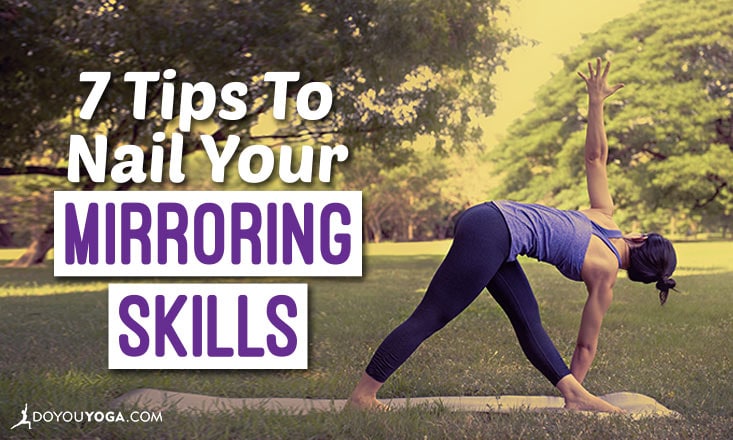Unless you have some experience as a dancer or dance instructor, mirroring probably doesn't come easily to you.
Somehow your left becomes right, right becomes left, and more often than not, the signals get crossed somewhere along the line and you end up getting tongue-tied (have you tried mirroring Parivrtta Ardha Chandrasana? What a nightmare). It's a skill that requires concentration and strong mind-body connection, but also one that helps to create an additional opportunity for your students to learn visually and understand how best to enter and exit a pose safely.
Like all teaching skills, practice makes perfect, but here are some neat little tried and tested tips from yoga teachers that can make mirroring a little less frustrating.
1. Start your flow on the same side every time.
"After deep oblique poses, or twists that get into the transverse core musculature, a great counter flow to experience release and expansion is the Warrior 2 – Reverse Warrior – Warrior 2 – Side Angle – Warrior 2 common flow.
If the class if right foot forward, left foot back, I'll be left foot forward, right foot back. I always demo the first flow with the students, consciously ensuring that I state the foot, leg, side body/ribs, arm and fingertips that I am demonstrating." – Cynthia Koch, Yoga Garden San Francisco.
2. Use a Sharpie.
"For the first several months that I taught, I would write a letter R on my left index finger, and a letter L on the right, so I got used to pointing in a direction while having a simple reminder of which side I was indicating.
As time went on and it got more intuitive, I stopped the practice, but it was a useful tool in the beginning." – Gillian Confair, The Pad Studios San Francisco.
3. Wear jewelry!
"I wear 3 bangles on my left which is actually my right when I'm teaching, and 2 on my right which is actually my left. I'm right handed, so naturally I always want to lead with my right side, so I always do what feels natural in my body and simply say left instead of right." – Saffron Fitton, Paradise Tribe Yoga in Bali.
4. Set an intention.
"In order to master mirroring, stick with your decision to mirror every move throughout a class. Set the intention at the beginning of the class — "for the next 90 minutes my right side will be my LEFT, and my left side will be my RIGHT."
I know that sounds overly simplified, but it works!" – Melinda DiOrio, yoga teacher and photographer, Melinda DiOrio Photography & Yoga.
5. Make use of your settings.
"I teach in an open-air studio. To the right, there's an ocean so I always cue the ocean when we do the right side. That way I know that the other side is always on the left." – Yuliya Popova, Redwoods Yoga San Francisco.
6. Look at your students
My personal tip is to look at your students. Forget about your left arm being their right — just look at their bodies and notice which arm they have reaching forward, or which leg they need to step back.
When you are demonstrating a pose, it's likely that your students will naturally follow along unless you have asked them not to (such as when you're teaching a challenging pose). So get out of your own head and focus on your students, this way you're not having to constantly "flip" your left into right and vice versa!
7. Last but not least, let it go.
"Honesty and humor! Accept that it's totally okay that you are not perfect. I just make fun of it that I sometimes mix up left and right. I was once in a class with Katchie Ananda who spoke frankly about her "Left-Right-Dyslexia" which made her even more likable.
Since then I handle it the same way and may add a story about my funniest mix ups when it happens." Sandra von Zabiensky, Satyaloka Yoga Germany.
Thankfully, symmetrical poses like prasarita padottanasana or paschimottanasana don't involve too many left/right cues; you can also cheat (a little) by using broader cues such as "step your back foot forward" and "reach your arms towards the window wall."
What are some other ways to become more comfortable with mirroring? Share your tips with us in the comments section!


